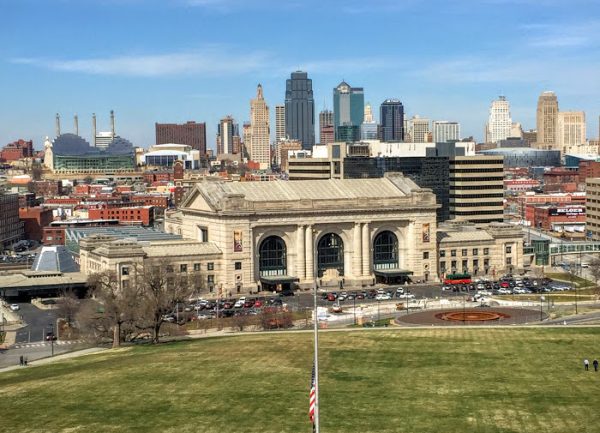Winter storm sparks discussions
People walk into the South Ferry-Whitehall St subway station in New York City during the storm on Thursday, January 4. By Metropolitan Transportation Authority of the State of New York from United States of America [CC BY 2.0 (http://creativecommons.org/licenses/by/2.0)], via Wikimedia Commons
On Jan. 3, a winter storm hit the East Coast of the United States, bringing snow and winds from Maine to parts of Florida. New England areas received nearly a foot of snow, Boston’s streets were flooded from a high tide and iguanas across Florida fell from trees because of the cold.
The storm was caused by a change in the jet stream, a high atmospheric current which circulates air across the globe and a low air pressure event over the Atlantic Ocean commonly known as a “bomb cyclone.” A northward shift in the jet stream occurred over the Pacific Ocean, bringing warm air from the tropics north to Alaska.
The shift caused another section of the jet stream to dip south, pushing cold air down from the Hudson Bay to eastern states. At one point, Anchorage, AK. was actually warmer than Jacksonville, FL. Differences in temperature between the Gulf Stream over the Atlantic Ocean and land caused a significant drop in air pressure, allowing for the storm to increase in speed.
“When you have the Gulf Stream just off the east coast, that naturally leads to warmer conditions, and when you get this cold air coming in behind it or coming in from the north that leads to that very tight temperature gradient from just off the southeast coast onto the mainland of the east coast,” said meteorologist Ed Vallee in an interview with Vox. “Those types of temperature gradients are typically a railroad track, so to speak, that the storms can form along and ride up along, and that kind of helps to increase the lift in the atmosphere and ultimately the amount of precipitation that falls.”
From Dec. 31 to Jan. 13, the average temperature for Greensboro was just 34 degrees Fahrenheit, with a low of 7 degrees Fahrenheit on Jan. 7.
Several Guilford students who went home for the break also experienced severe cold and snow.
“The weather was horrible. The weather was very cold, and sometimes it even got to minus 15 degrees,” said first-year Jennifer Sikorski, who spent her break in Hatfield, MA. “Around me, there were accidents on the road, it would snow, and the wind (would) take all that snow, and put it on the road. And traveling was hard, and people all around me were sick.”
Winter storms often cause damage to infrastructure and an increase in traffic accidents, which Massachusetts experienced this year when 20,000 people lost power.
The cold weather has led some to express skepticism toward climate change.
“In the East, it could be the coldest New Year’s Eve on record. Perhaps we could use a little bit of that good old Global Warming that our Country, but not other countries, was going to pay TRILLIONS OF DOLLARS to protect against. Bundle up!” tweeted President Donald Trump on Dec. 28.
The reasons for this skepticism may be influenced by several factors.
“I believe many public figures deny climate change for a variety of reasons, some based on their ties to monetary compensation or power,” said Visiting Lecturer for Environmental Studies Bronwyn Tucker. “I think it’s difficult for a public figure to assert that society will have to make some drastic lifestyle changes without fearing they will lose popularity, and thus power.”
Despite overwhelming scientific consensus on the reality of human-caused climate change, many constituents are likely to take Trump’s statement as a fact. According to a 2016 poll by the Yale Program on Climate Communication, only 53 percent of the American public agreed that climate change was indeed real and caused by human activities. By comparison, multiple studies in peer-reviewed journals concluded that 97 percent of climate scientists agree that human-caused climate change is occurring.
Because of its destabilizing effect on the earth’s natural regulatory systems, climate change may actually increase the frequency severity of extreme winter storms. A weather pattern known as the “polar vortex” usually keeps extremely frigid air trapped inside the Arctic, but a 2017 study by the American Meteorological Society found that rapid melting and climate warming have caused this vortex to weaken. The result is Arctic air being pushed south more often, leading to colder winters and more intense storms in some regions.
“Global warming affects the severity of storms as it does not simply impact the heating of the Earth, but a series of components which go into the general functions of the atmosphere,” said Early College student Kayleigh Cook. “What they might not know is that our weather balances put the record-breaking highs in the other half of the world such as those recorded in Australia.”
Just because it’s cold outside does not mean global warming is not happening.

![People walk into the South Ferry-Whitehall St subway station in New York City during the storm on Thursday, January 4. By Metropolitan Transportation Authority of the State of New York from United States of America [CC BY 2.0 (http://creativecommons.org/licenses/by/2.0)], via Wikimedia Commons](https://www.guilfordian.com/wp-content/uploads/2018/01/South_Ferry_snow_vc-900x600.jpg)







